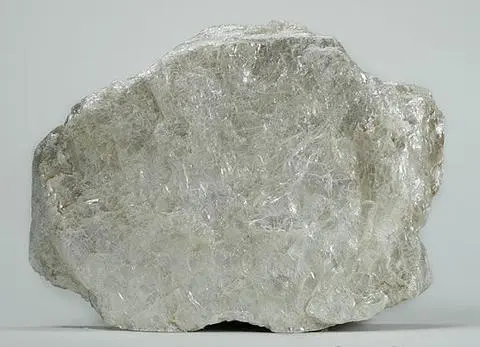
Appearance
Talc is a member of the phyllosilicate mineral group, which is distinguished by its layered composition. Thin sheets or layers of silicon, oxygen, and magnesium atoms organized in a hexagonal arrangement make talc crystals. Talc’s distinctive “soapy” texture and ease of cleaving into thin sheets are caused by the layers’ poor bonding and tendency to slide over one another. The color of talc can range from white to gray, pale green, or even colorless. Its cleavage surfaces have a glossy or oily sheen. Talc can be transparent or opaque, and it frequently takes the form of foliated aggregates or finely grained masses.
Geographical Distribution
There are talc deposits all over the world, and they are frequently found in areas that have experienced intense geological activity. Among the noteworthy places are China, India, France, Italy, and the United States. Additionally, talc deposits can be discovered in Afghanistan, Pakistan, Australia, and Brazil.
History
Given that talc produces flames that resemble mica, it is thought that the name “talc” originated from the Arabic word “talc” or “talk.” Georgius Agricola gave the current name in 1564. Talc is also commonly referred to as kerite.
Metaphysical Properties
Metaphysical beliefs state that talc provides good fortune and improves mental purity and clarity. Paint, plastics, paper, ceramics, foam packing materials, cosmetics, and talcum powder are among the products made from talc mines.

Chemical Composition
Talc is a magnesium silicate mineral with the molecular formula Mg3Si4O10(OH)2.
Uses
- Medicine and Healing: Because of its calming and absorbing qualities, talc was employed in medical procedures. It was used as a component of poultices, to cure wounds, and to relieve skin irritations.
- Cosmetics and Personal Care: As a component in talcum powder, talc has become incredibly popular in recent times. It was the perfect material for items meant to keep the skin dry and avoid chafing because of its capacity to absorb moisture and lower friction.
- Industrial Applications: The benefits of talc go beyond personal hygiene. Its qualities as a filler, extender, and enhancer of physical properties make it useful in a variety of sectors, including plastics, ceramics, paint, and paper.
- Legal and Health Controversies: Talc is widely used, but it hasn’t been without controversy. Some talc resources include asbestos, a material that can cause cancer, which has raised concerns. Furthermore, there have been discussions on the potential connection between talcum powder use and ovarian cancer, which has resulted in legal actions and regulatory examination.
- Ongoing Research and Innovation: Research and innovation on talc are still ongoing. Researchers are looking for ways to enhance its characteristics, enhance extraction techniques, and create sustainable habits.




